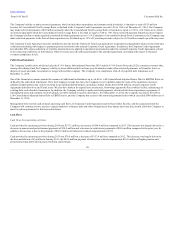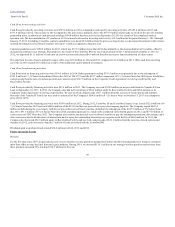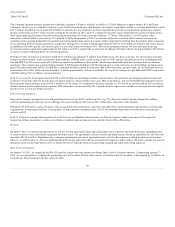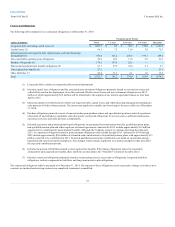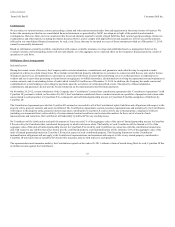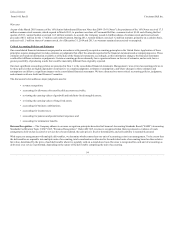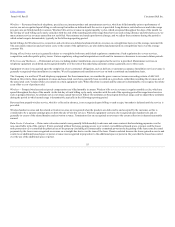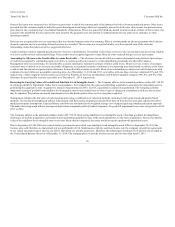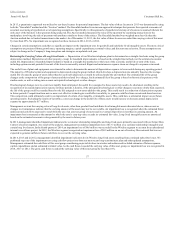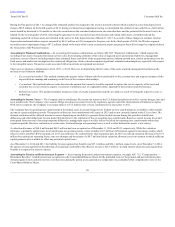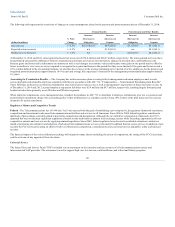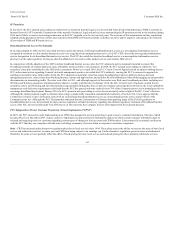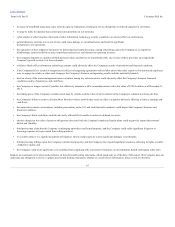Cincinnati Bell 2014 Annual Report Download - page 58
Download and view the complete annual report
Please find page 58 of the 2014 Cincinnati Bell annual report below. You can navigate through the pages in the report by either clicking on the pages listed below, or by using the keyword search tool below to find specific information within the annual report.
Table of Contents
Form 10-K Part II
Cincinnati Bell Inc.
During the first quarter of 2013, we changed the estimated useful lives assigned to the wireless network software which resulted in a one-time depreciation
charge of $8.5 million. In the fourth quarter of 2013, during our annual asset impairment testing, we determined the estimate of our useful lives of all wireless
assets should be shortened to 30 months to take into consideration the continued reduction in our subscriber base and the potential for the asset lives to be
limited. In the second quarter of 2014, following the agreement to sell our wireless spectrum licenses and certain other assets, we further reduced the
remaining useful life of those assets not included in the sale to be fully depreciated as of March 31, 2015. As a result of these changes in estimate, wireless
depreciation and amortization expense increased by $62.2 million in 2014 compared to the prior year. In the third quarter of 2014, the Wireless segment
recorded an asset impairment charge of $7.5 million related to the write-off of certain construction-in-process projects that will no longer be completed due to
the wind down of the Wireless business.
In accounting for business combinations, we follow ASC 805, "Business Combinations," which requires the
recording of net assets of acquired businesses at fair value. In developing estimates of fair value of acquired assets and assumed liabilities, management
analyzes a variety of factors including market data, estimated future cash flows of the acquired operations, industry growth rates, current replacement cost for
fixed assets, and market rate assumptions for contractual obligations. Such a valuation requires significant estimates and assumptions, especially with respect
to the intangible assets. Transaction costs associated with acquisitions are expensed as incurred.
There were no business combinations in 2012, 2013, or 2014. However, in determining the fair value of the assets acquired, management has historically
utilized several valuation methods:
•Excess earnings method: This method estimates the present value of future cash flows attributable to the customer base and requires estimates of the
expected future earnings and remaining useful lives of the customer relationships.
•Cost method: This method indicates value based on the amount that currently would be required to replace the service capacity of the asset and
considers the cost of a buyer to acquire or construct a substitute asset of comparable utility, adjusted for deterioration and obsolescence.
•Relief-from-royalty: This method estimates the present value of royalty expense that could be avoided as a result of owning the respective asset or
technology.
The Company and its subsidiaries file income tax returns in the U.S. federal jurisdiction as well as various foreign, state and
local jurisdictions. The Company’s previous tax filings are subject to normal reviews by regulatory agencies until the related statute of limitations expires.
With a few exceptions, the Company is no longer subject to U.S. federal, state or local examinations for years prior to 2011.
The Company has net operating loss carryforwards at the federal, state, local and foreign levels. Federal tax loss carryforwards are available to offset taxable
income in current and future periods. The majority of these tax loss carryforwards will expire in 2023 and are not currently limited under U.S. tax laws. The
ultimate realization of the deferred income tax assets depends upon our ability to generate future taxable income during the periods in which basis
differences and other deductions become deductible and prior to the expiration of the net operating loss carryforwards. Based on current income levels and
anticipated future reversal of existing temporary differences, management expects to fully utilize its federal net operating loss carryforwards within their
expiration periods. However, realization of certain state, local and foreign net operating losses, as well as other deferred tax assets, is not certain.
A valuation allowance of $64.4 million and $68.3 million has been recognized as of December 31, 2014 and 2013, respectively. While the valuation
allowance is primarily against state, local, and foreign net operating losses, it also includes $10.7 million of allowances against Texas margin credits, which
effective with CyrusOne's IPO on January 24, 2013, are unlikely to be realized before their expiration date. In 2014 we reduced valuation allowances by $3.9
million for expiring net operating losses, state rate changes and the release of a $0.7 million federal valuation allowance on an investment in which sufficient
capital gains are now available to offset any potential capital losses.
As of December 31, 2014 and 2013, the liability for unrecognized tax benefits was $27.1 million and $24.1 million, respectively. As of December 31, 2014,
the amount of unrecognized tax benefits that, if recognized, would affect the effective tax rate is $26.3 million. Accrued interest related to unrecognized tax
benefits is recognized in interest expense.
In accounting for pension and postretirement expenses, we apply ASC 715, "Compensation —
Retirement Benefits." A liability has been recognized on the Consolidated Balance Sheets for the unfunded status of the pension and postretirement plans.
Actuarial gains (losses) and prior service costs that arise during the period are recognized as a component of accumulated other comprehensive loss on the
Consolidated Balance Sheets.
58


